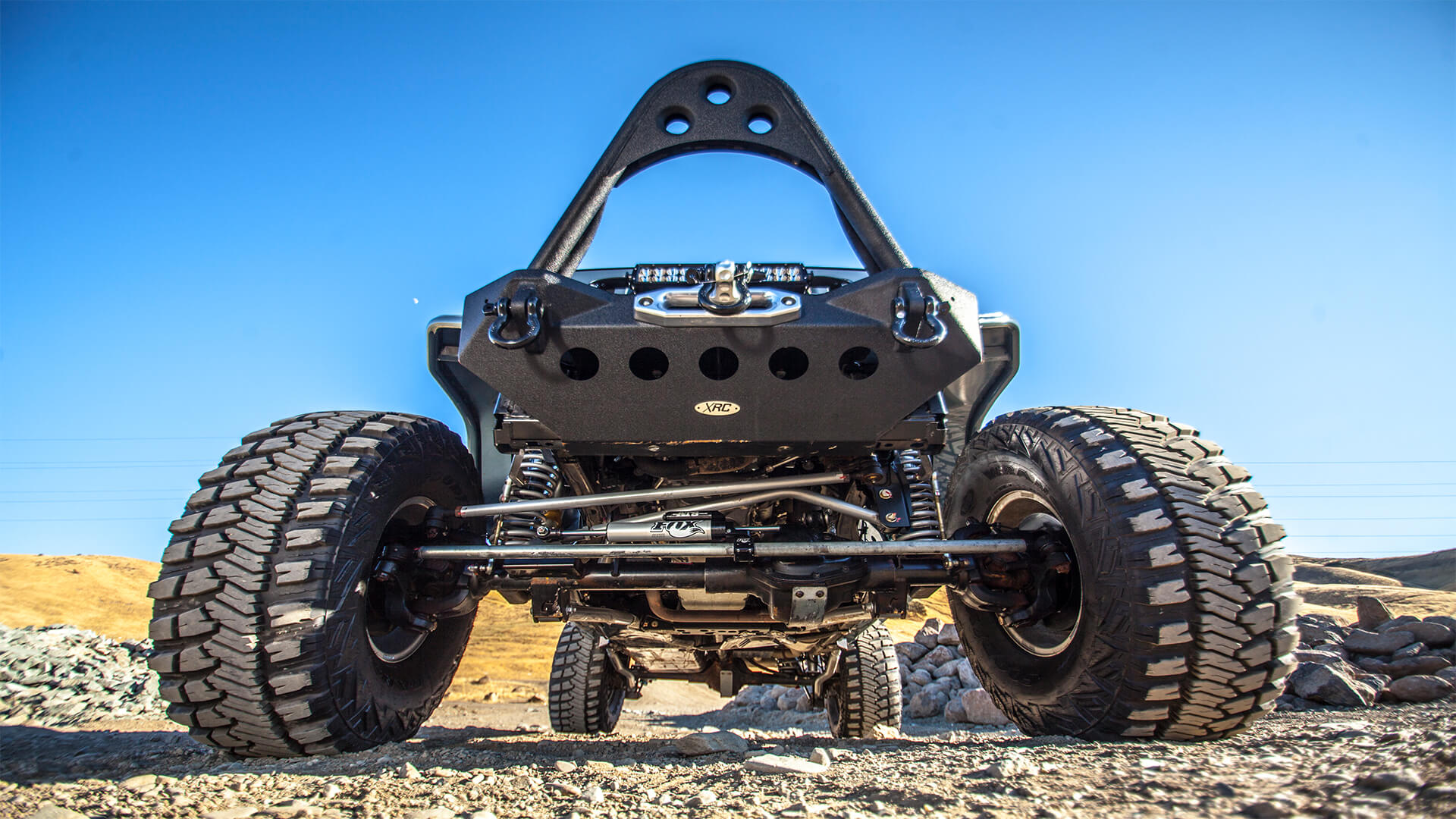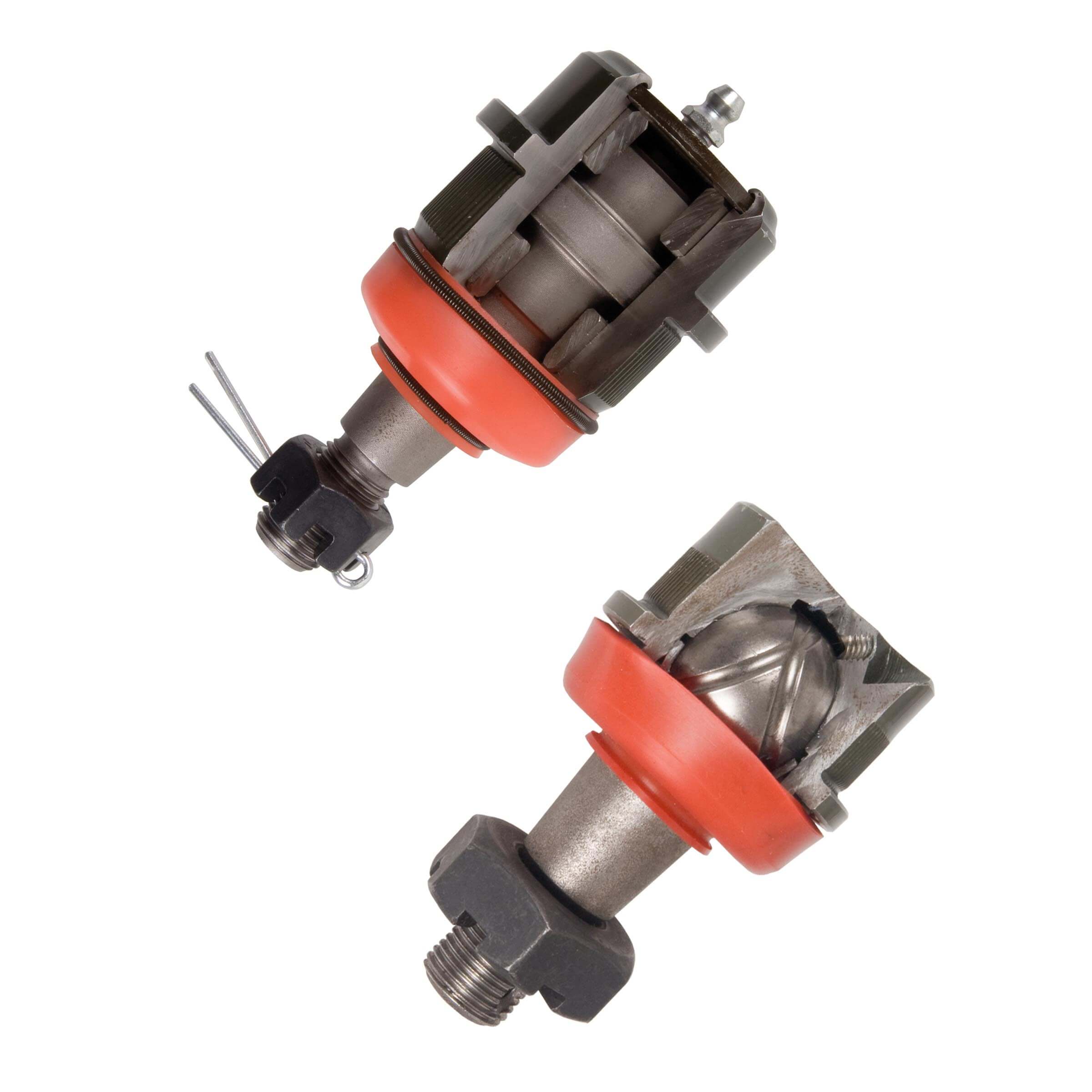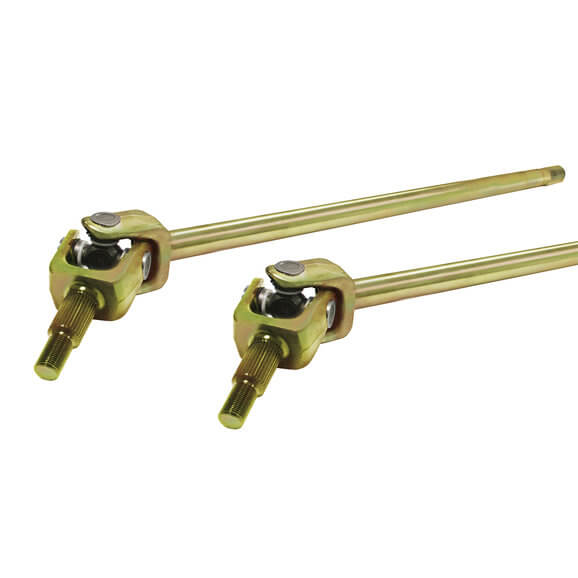
It’s no secret, the Jeep JK is the darling of the aftermarket. Bypass shocks, loads of suspension travel, tons of armor, lights, bumpers and whatever else you can think of can be bolted to Jeep JK without much effort. Anything from basic to completely ballistic is available for the JK. If something isn’t available yet, chances are good that someone is thinking of building it.
That same love extends to the drivetrain of the Jeep JK – and for good reason. First, the Jeep JK tends to get used off-road more than other vehicle. But its stock drivetrain suffers from some severe weak points. It’s a solid recipe for busted parts when out on the trail.
Thankfully, the aftermarket is here to help. There are a ton of upgrades that can beef up your Jeep. In fact, there are so many it can get pretty overwhelming. Which ones do you really need, and which can you go without? What size tires can you run with those parts? Those are great questions we get asked all the time. So, let’s try to answer them.
Before we go further, we need to talk about maximum tire sizes. Our recommendations are made for those who use their JKs on tougher trails and know they’re not driving an Ultra4 car. If you’re just out exploring, mall crawling, camping, or doing some light wheeling the stock axles will be fine. These recommendations are from our experience. Yes, we know there’s a guy on an Internet forum somewhere who wheels hard with a Dana 30 and 40-inch tires without ever breaking anything. However, in our experience that is not the norm. Let’s take a look at the more common size tire and axle combinations we most frequently are asked about. Even with these recommendations it is important to remember that one of the biggest factors in making any axle/tire combination live is the driver.

Upgrading the ball joints is a must for any Jeep JK running bigger tires with the Dana 30 axle or Rubicon 44. The factory ball joints use a plastic liner that wears out fast causing death wobble and sloppy handling. Aftermarket ball like those from Synergy, G2, Alloy USA, and others get rid of the plastic liner using a sintered metal on bushing design. They also use stronger chromoly balls and studs and beefier housings.
FRONT DANA 30+35s
Parts You Will Need: Heavy-duty ball joints, upgraded axle shafts, upgraded u-joints, axle truss, gears
The Dana 30 front axle found underneath Jeep JKs is its Achilles Heel. In tough terrain it really isn’t up to the task of running much larger than factory tires in stock form. Its housing is known to bend easily, its shafts can snap, and u-joints pop when teamed up with larger tires and harder trails. Even with stock size tires, its ball joints only last so long before wearing out. That’s really a shame since the wheel wells of the JK can easily clear a 35-inch tire with just a slight lift.
Luckily, there are lots of upgrades to make running 35s possible. One of our first mods would be to truss or sleeve the bend-prone tubes of the Dana 30 and reinforce its weak Cs. While this might seem a bit extreme, it is lot easier to truss an axle before it bends than after. Even if we were keeping our tire sizes close to stock, we would ditch the factory ball joints for heavy-duty ones and get rid of the wear-prone plastic liners. The factory shafts should also be yanked in favor of much stronger chromoly ones. We would make sure these new shafts accept a larger 1350 series u-joint and full circle clips. Of course, the right gearing to match 35s is a necessity, as well. None of this is cheap, but can be done in stages if needed.

The Dana 30 and the Rubicon Dana 44 both share the same axle tubes that are fairly thin and known to bend. Two options exist to keep bending from happening: trussing and sleeving. Of the two trussing is generally considering to have an edge in strength. Just remember to have one properly installed by a skilled welder so your axle doesn’t get warped during the install.

An easy way to add some much needed strength to the Dana 30 front axle is with upgraded axle shafts. Look for ones constructed from stronger chromoly steel for a decent bump in strength. A reinforced yoke area adds strength to an area that often fails. Ones that are machined for full circle retaining clips will be more effective at keeping the u-joint from “walking” out of the ears and snapping. Many also allow for the use of the larger 1350-style u-joints.
FRONT DANA 30+37s
Parts You Will Need: A different axle
No matter what you have read, there really is no way to make a Dana 30 reliably take on tough trails with 37-inch tires. Eventually something is going to break and keep on breaking. Even with all the above mods, the Dana 30s tiny ring and pinion, thin tubes, and weak shafts aren’t going to hold up. If you are the type who loves to bring a trail ride to a screeching halt while you fix yet another broken shaft, then by all means carry a bunch of spares. Otherwise, the solution is a complete axle swap.
The good news is there are plenty of bolt-in swaps that can handle 37s. Currie’s RockJock 44, G2’s CORE 44, and Dynatrac’s ProRock 44 vary in some aspects. But what they all offer are significantly stronger housings, bigger ring and pinion gears, and beefier axle shafts and u-joints that can handle life with 37s. Yes, they are more expensive than throwing the kitchen sink of mods at the Dana 30. However, when you add up all the costs and labor (if you aren’t installing them yourself) for those parts, the jump in cost is not as significant. For us, the peace of mind from not having to constantly worry about breakage is worth the extra money.

If you plan to run 37s on your non-Rubicon JK, you are going to need to swap in a stronger axle. Aftermarket axles, like the CORE 44, eliminate the weak points of a Dana 30 by offering much stronger housings, better axle shafts with bigger u-joints, and a larger ring and pinion gears. While it is a more expensive option, we have seen lots of guys throw the kitchen sink (and lots of money) at the Dana 30 only to upgrade to an aftermarket 44 later. In the long run it may be better to save your money for the 44.
RUBICON 44+37s
Parts You Will Need: Heavy-duty ball joints, upgraded axle shafts, axle truss, gears
The good news is that you plunked down the extra cash for the Rubicon package. That nets you a front Dana 44 axle and a host of other upgrades. The bad news is that Rubicon Dana 44 axle is a mix between a Dana 30 and a Dana 44. Yes, the Rubicon 44 has a larger (and stronger) 8.5-inch ring gear, and better 30-spline shafts. However, the rest of the Dana 44 is pretty much the same as the Dana 30. That means you get the same weak axle tubes and Cs as the Dana 30.
With that in mind, it’s not surprising that our upgrade list for the Rubicon 44 is similar to that of the Dana 30. A truss is needed to keep the thin axle tubes from bending, and the Cs will need to be strengthened. While the Rubicon 44 comes with better shafts with larger u-joints, we’d still upgrade them. Doing so would net us stronger chromoly shafts and the ability to run full circle u-joint clips. Plus, we could keep the stock shafts as ready-to-go spares should we ever snap the new shafts.

Another weak point of the Dana 30 are its Cs. They are fairly light duty and can bend under harder use. This won’t necessarily end your day of wheeling but can cause handling issues as well as chew through ball joints and bearings. Aftermarket axles (like the CORE 44 seen here) are much beefier in this area.
RUBICON 44+40s
Parts You Will Need: A different axle
Running 40-inch tires on Rubicon axles in tough terrain just isn’t going to happen without breakage. Yes, we know it is a bit of a bummer but that’s the reality. The ring gear size, thin tubes, and medium size axle shafts aren’t up to the weight and abuse that a 40-inch tire will bring. Sorry to burst your bubble.
The only way to run a 40-inch tire on a JK without breakage is to swap in a set of Dana 60s. Currie, Dynatrac, and Dana make options that bolt right into a JK without much fuss. They are in no way cheap, but they offer a massive increase in strength over any other offering for the JK. While variations between the different axle makers’ Dana 60s exist, all of them offer a stout 10-inch ring gear and beefy 35-spline axles. The housing and tubes are also very strong with 3.5-inch diameter tubes up to .370-inches thick. Everything is much stronger on a Dana 60 and they can handle serious abuse. Plan on spending at least $13,000 for both a front and rear axle. As the saying goes, you gotta pay to play.

If 40-inch tires and up are in your future you better start saving up as aftermarket Dana 60s are not cheap. They are however a huge upgrade in strength with a 10-inch ring gear, 35-spline axle shafts, massive u-joints, and .370-inch thick tubes. Yes you can still break a Dana 60, but you have to be trying pretty hard.
REAR DANA 44 + 37s
Parts You Will Need: Upgraded shafts
The rear Dana 44 on the Jeep JK is actually not a bad axle. It uses much thicker axle tubes than the front Dana 44. Another plus is it uses a larger 8.8-inch diameter ring gear. Rubicon models get 32-spline axle shafts while all other JKs use 30-spline shafts. One weak point of the axle are the flanges can bend under harder use.
If you are beating on your JK in the desert, then a truss might be a worthy investment. Otherwise, we would focus on swapping in a set of chromoly shafts. With the semi-float nature of the rear Dana 44, breaking a rear axle can be a serious pain. Stronger shafts will keep this to a minimum.

Another benefit to an axle swap is that all of the brackets for the track bar and controls are fairly thin on a stock Dana 30 and Rubicon 44. Aftermarket housings use much thick brackets and mounts for an upgrade in strength. Plus, you don’t have to spend a ton of time welding on brackets like you would have to do with a junkyard axle

One fact that sometimes doesn’t get discussed that much is that as you gear down, the pinion gear becomes physically smaller. This can mean that lower gear ratios in axles that have smaller ring gears, such as the Dana 30’s 7.12.-inch ring gear, can be fairly weak. While other parts of the axle can be upgraded, the only way to change ring gear diameter is to step up to a larger axle. Rubicon Dana 44s have an 8.5-inch front ring gear while Dana 60s use a 10-inch gear.



What is your advice with a Dana 44 front with CVR axel shafts , Heavy duty Ball joints upper and lower, on 38” tires and I don’t wheel, I just do forest trails . I hate rocks.